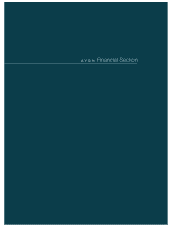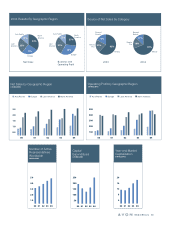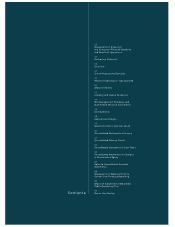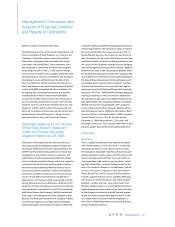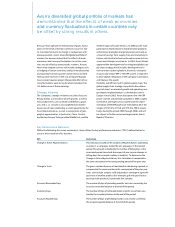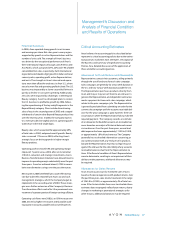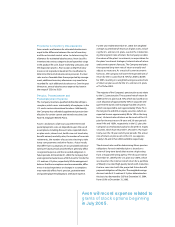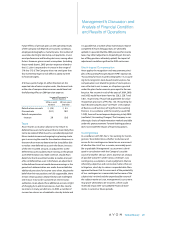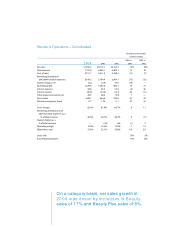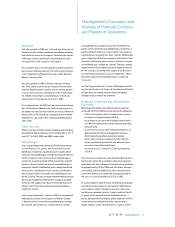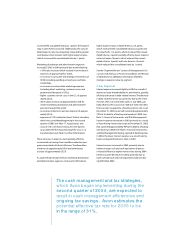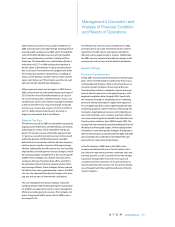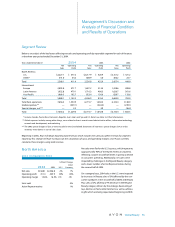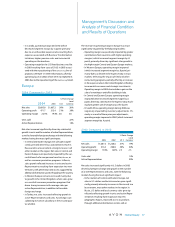Avon 2004 Annual Report Download - page 7
Download and view the complete annual report
Please find page 7 of the 2004 Avon annual report below. You can navigate through the pages in the report by either clicking on the pages listed below, or by using the keyword search tool below to find specific information within the annual report.
Provisions for Inventory Obsolescence
Avon records an allowance for estimated obsolescence
equal to the difference between the cost of inventory
and the estimated market value. In determining the
allowance for estimated obsolescence, Avon classifies
inventory into various categories based upon their stage
in the product life cycle, future marketing sales plans and
the disposition process. Avon assigns a degree of obso-
lescence risk to products based on this classification to
determine the level of obsolescence provision. If actual
sales are less favorable than those projected by manage-
ment, additional inventory allowances may need to be
recorded for such additional obsolescence. Over the past
three years, annual obsolescence expense has been in
the range of $55.0 to $65.0.
Pension, Postretirement and
Postemployment Expense
The Company maintains qualified defined benefit pen-
sion plans, which cover substantially all employees in the
U.S. and in certain international locations. Additionally,
the Company has unfunded supplemental pension ben-
efit plans for certain current and retired executives (see
Note 10, Employee Benefit Plans).
Avon’s calculations of pension, postretirement and
postemployment costs are dependent upon the use of
assumptions, including discount rates, expected return
on plan assets, interest cost, health care cost trend rates,
benefits earned, mortality rates, the number of associate
retirements, the number of associates electing to take
lump-sum payments and other factors. Actual results
that differ from assumptions are accumulated and amor-
tized over future periods and, therefore, generally affect
recognized expense and the recorded obligation in
future periods. At December 31, 2004, the Company had
unrecognized actuarial losses of $476.3 and $213.6 for the
U.S. and non-U.S. plans, respectively. While management
believes that the assumptions used are reasonable, differ-
ences in actual experience or changes in assumptions
may materially affect Avon’s pension, postretirement
and postemployment obligations and future expense.
For the year ended December 31, 2004, the weighted
average assumed rate of return on all plan assets, includ-
ing the U.S. and non-U.S. plans, was 8.21%. In determin-
ing the long-term rates of return, the Company considers
the nature of the plans’ investments, an expectation for
the plans’ investment strategies, historical rates of return
and current economic forecasts. The Company evaluates
the expected long-term rate of return annually and
adjusts as necessary. As a result of current economic
forecasts, the Company will lower the expected rate of
return for the U.S. plan from 8.75% for 2004 to 8.00%
for 2005, resulting in a weighted average assumed rate
of return on plan assets for the U.S. and non-U.S. plans
of 7.67% for 2005.
The majority of the Company’s pension plan assets relate
to the U.S. pension plan. The assumed rate of return for
2004 for the U.S. plan was 8.75%, which was based on an
asset allocation of approximately 35% in corporate and
government bonds and mortgage-backed securities
(which are expected to earn approximately 5% to 7% in
the long term) and 65% in equity securities (which are
expected to earn approximately 8% to 10% in the long
term). Historical rates of return on the assets of the U.S.
plan for the most recent 10-year and 20-year periods
were 9.4% and 10.8%, respectively. In the U.S. plan, the
Company’s asset allocation policy has favored U.S. equity
securities, which have returned 11.2% and 13.1%, respec-
tively, over the 10-year and 20-year periods. The actual
rate of return on plan assets in the U.S. was approxi-
mately 12% and 21% in 2004 and 2003, respectively.
The discount rate used for determining future pension
obligations for each individual plan is based on a
review of long-term bonds that receive a high rating
from a recognized rating agency. The discount rate at
December 31, 2004 for the U.S. plan was 5.80%, which
was based on the internal rate of return for a portfolio
of Moody’s Aa-rated high quality bonds with maturities
that are consistent with the projected future benefit
payment obligations of the plan. The weighted average
discount rate for U.S. and non-U.S. plans determined on
this basis has decreased to 5.65% at December 31, 2004,
from 6.03% at December 31, 2003.
Avon will record expense related to
grants of stock options beginning
in July 2005.

